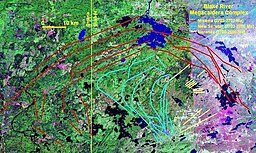Blake River Megacaldera Complex
| Blake River Megacaldera Complex | |
|---|---|

Map of the Blake River Megacaldera Complex. Misema Caldera is highlighted in red, New Senator Caldera in cyan and Noranda Caldera in pale yellow.
|
|
| Location | Ontario-Quebec, Canada |
| Coordinates | 48°20′05″N 79°16′20″W / 48.334744°N 79.272093°WCoordinates: 48°20′05″N 79°16′20″W / 48.334744°N 79.272093°W |
| Range | Canadian Shield |
| Geology | Calderas |
| Age | 2,706 million years ago |
| Volcanic arc/belt | Abitibi greenstone belt |
| Last eruption | 2,696 million years ago |
The Blake River Megacaldera Complex is a giant subaqueous caldera cluster or a nested caldera system that spans across the Ontario-Quebec border in Canada.
The caldera complex is around 2.7 billion years old, consisting of a series of overlapping calderas of various ages and sizes. It lies within the southern zone of the Abitibi greenstone belt of the Superior craton and has an area of 3,000 km2 (1,200 sq mi).
The Blake River Megacaldera Complex has been a centre of major interest since 2006 with numerous excursions at the international, national and local level. It is a world-class metallotect with respect to both hydrothermal Cu-Zn massive sulfides and gold-rich massive sulfides.
The Blake River Megacaldera Complex consists of mainly mafic to intermediate volcanic flows and less abundant felsic volcanic flows and intercalated pyroclastic rocks, which underwent three stages of major volcanic activity.
The Blake River Megacaldera Complex is considered a supervolcano due to its great size and its multiple dikes and vents. The Misema Caldera is in the order of 3,500 to 4,000 km2 (1,400 to 1,500 sq mi), making the complex similar to the Yellowstone Caldera in Wyoming, Lake Toba in Indonesia and strikingly similar in structure to the Olympus Mons caldera on Mars. As a result, the Blake River Group is best categorized as a meganested caldera complex.
...
Wikipedia
